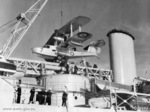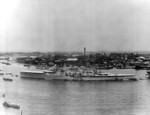Walrus
| Country | United Kingdom |
| Manufacturer | Supermarine Aviation Works |
| Primary Role | Seaplane |
| Maiden Flight | 1 January 1935 |
Contributor: C. Peter Chen
ww2dbaseThe Walrus amphibious reconnaissance aircraft were designed by R. J. Mitchell of Supermarine Aviation Works. They were meant to be launched from ship-borne catapults, and they were the first such amphibious aircraft in the world while carrying a full military load. In 1935, Walrus aircraft entered service with the Royal Australian Air Force under the Seagull V A2 designation. On 16 Mar 1936, they entered service with the British Royal Air Force. In the same year, the New Zealand division of the British Royal Navy also received them. By the time the European War began, they were in widespread use. During the war, they were credited with sinking or damaging at least five German submarines and rescuing many downed airmen. The Irish Air Corps used them during the Irish Emergency period during WW2 for maritime patrol. After the war, one Walrus aircraft, HD874, participated with the Australian Antarctic Expedition in 1947.
ww2dbaseA total of 740 Walrus aircraft were built. They were built in three major variants. The original metal hull variant was designated Seagull V, the second metal hull variant was designated Walrus I, and the wooden hull variant was designated Walrus II. Some of the nicknames for the aircraft include "Shagbat" and "Steam Pigeon".
ww2dbaseSource: Wikipedia.
Last Major Revision: Jun 2008
SPECIFICATIONS
Walrus
| Machinery | One Bristol Pegasus VI radial engine rated at 680hp |
| Armament | 2x7.7mm Vickers K machine guns, 345kg of bombs or depth charges |
| Crew | 3 |
| Span | 14.00 m |
| Length | 11.45 m |
| Height | 4.60 m |
| Wing Area | 56.70 m² |
| Weight, Empty | 2,220 kg |
| Weight, Loaded | 3,265 kg |
| Speed, Maximum | 215 km/h |
| Rate of Climb | 5.30 m/s |
| Service Ceiling | 5,600 m |
| Range, Normal | 965 km |
Photographs
 |  |  |  |
Did you enjoy this article or find this article helpful? If so, please consider supporting us on Patreon. Even $1 per month will go a long way! Thank you. Share this article with your friends: Stay updated with WW2DB: |
Visitor Submitted Comments
All visitor submitted comments are opinions of those making the submissions and do not reflect views of WW2DB.
- » Wreck of USS Edsall Found (14 Nov 2024)
- » Autumn 2024 Fundraiser (7 Nov 2024)
- » Nobel Peace Prize for the Atomic Bomb Survivors Organization (11 Oct 2024)
- » Wreck of USS Stewart/DD-224 Found (2 Oct 2024)
- » See all news
- » 1,150 biographies
- » 337 events
- » 43,917 timeline entries
- » 1,241 ships
- » 350 aircraft models
- » 207 vehicle models
- » 375 weapon models
- » 123 historical documents
- » 260 facilities
- » 470 book reviews
- » 28,545 photos
- » 432 maps
Chiang Kaishek, 31 Jul 1937
Please consider supporting us on Patreon. Even $1 a month will go a long way. Thank you!
Or, please support us by purchasing some WW2DB merchandise at TeeSpring, Thank you!
10 Mar 2017 09:57:10 AM
thank u for a look into british ww2 history.